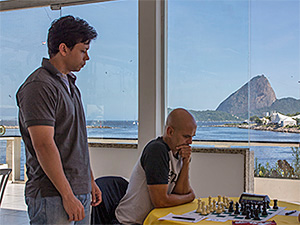Brazilian Championship: democracy restored
By Albert Silver
Over a frenetic period of four days, in which seven rounds of classical games were played, two qualifying events for the Brazilian national championship took place, one in the northernmost city Belém, and one in tropical Rio de Janeiro. Aside from the beautiful vista, seen below in the pictures, it also established an important change in the structure of the national championship, shrugging off the old format, used in many countries still, for a far more democratic structure.

The gorgeous view of the bay as seen from the balcony of the venue
Brazil has a modest total of eleven grandmasters, not all of whom are active, such as GM Sunye Neto, Brazil’s second grandmaster after legend Mecking, and in an effort to guarantee that the very best players fought for the title, a number of seeds used to be handed out to the top rated players, enabling them to bypass the onerous qualification process. Even so, the event did not always feature a top roster, and what happened instead was that the extra spot were then distributed either to an unlucky player who missed his chance, or anyone the Federation might be feeling friendly to. Favoritism and corruption were constant shadows in this process.
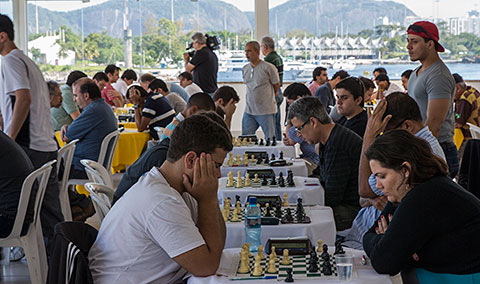
With four spots into the Brazilian championship, and prizes going down to the 20th
place, it was a hard-fought competition.

GM Rafael Leitão, the number one rating in Brazil, was not there as a benevolent
spectator, he was fighting for his own spot.
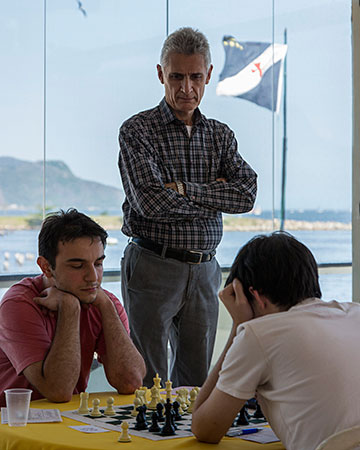
FM Alberto Mascarenhas, the president of the Rio de Janeiro Chess Federation,
watches the game by IM Diego Berardino (left) against FM Luiz Abdalla.
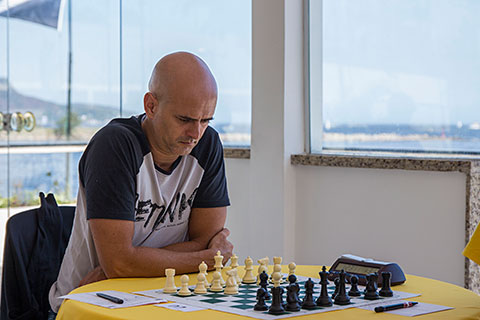
IM Christian Toth was not an Elo favorite, due to inactivity, but as the former teacher
of GM Giovanni Vescovi, his experience and knowledge reaped their rewards. He came
in second by tiebreak and was one of the qualifiers.
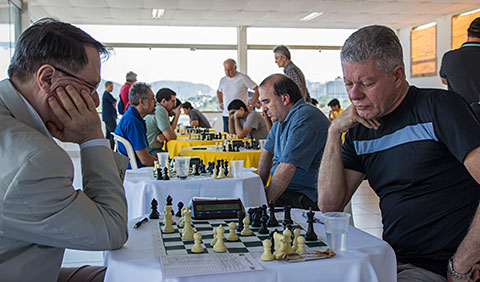
FM Ricardo Teixeira (right) came hoping for a repeat of his Cinderella result in 2002
when he came equal first in the national championship, for the right to play a match
against GM Darcy Lima for the title (Lima won). Sadly there were no glass slippers this time.
This time, the only players guaranteed a spot beforehand are the top three players from the previous year, while players automatically seeded due to their rating are a thing of the past. The Brazilian Federation retains the right to include a player of its choosing, as does the sponsor of the event. The final seven spots must all be decided in the heat of battle, and the result was two ‘Semifinals’ qualifying four and three spots respectively. Grandmasters wanting to add this feather to their cap must revalidate their favoritism by beating their lower-rated peers.
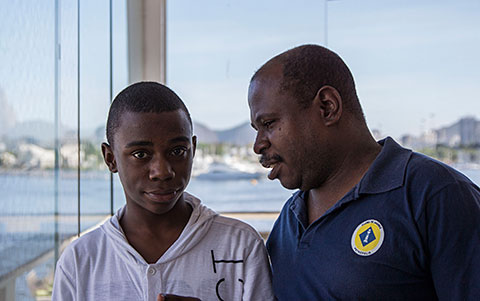
Many players brought their families as support or as players. Three-time Rio de Janeiro
State Champion Wagner Guimarães (right) chats with his son Lucas (left).

Could you wish for a more uplifting cheerleader?
One of the semifinals took place in Rio de Janeiro, and was held at the beautiful club of Vasco da Gama. Vasco today is best known for its football team, just like Flamengo or Fluminense among others, but just as these other well-known clubs, it was not founded as a football club, not even in this football-crazed country. In fact, they are all called the ‘Clube de Regatas’ which means the ‘yacht club’. Football and many of the other sports (basketball, volleyball, and more) championed by these clubs, including chess, are but pieces to a larger puzzle.
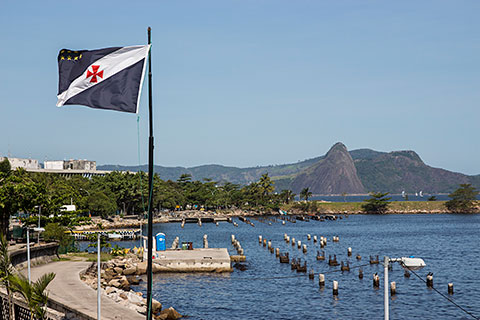
The view to the left of the club, with the flag of Vasco rippling in the wind
For decades Vasco competed actively in the State Team championships winning many titles, with a healthy rivalry with Tijuca Tênis, and others. Sadly, some twenty years ago, the club withdrew its support of the game of kings whether due to an apparent lack of interest, or simple cost-cutting. The club has changed this stance and is now actively seeking to revert this, by hosting event after event at its headquarters.
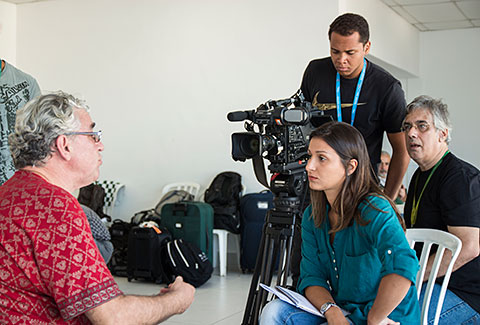
The TV media was there in full force, represented by SporTV, a cable channel
dedicated to sports. you can see the full video clip (four minutes long) of the
report here.
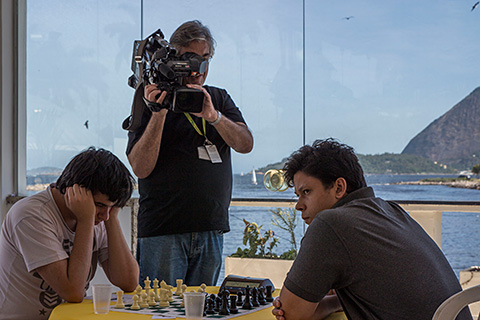
The cameras weren't always as discrete as the players might wish, but such
is the price of fame.
The top rated player in the competition was none other than the top rated player in Brazil, grandmaster Rafael Leitão, five-time Brazilian champion, and now a columnist in the Chess Informant. With 2634 FIDE, he came with a towering 200-plus Elo over the rest of the field, and showed his class by tearing through the players left and right with an untouchable 6.0/6. His only draw was in the last round, where with a 1.5 point lead, and guaranteed first, he could not muster the motivation to go for his opponent’s jugular with the same verve as earlier.
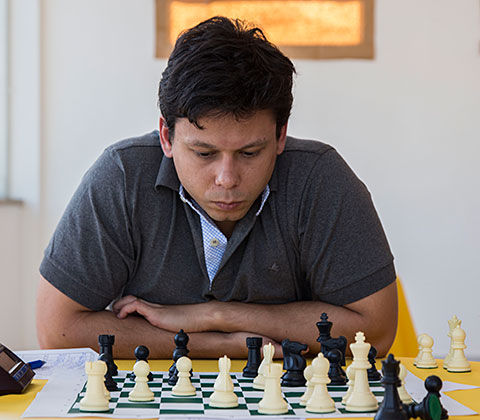
GM Rafael Leitão
GM Rafael Leitão commented his victory in round six:

[Event "Rio de Janeiro"] [Site "?"] [Date "2013.11.03"] [Round "6"] [White "Leitao, R."] [Black "Molina, R."] [Result "1-0"] [ECO "D20"] [Annotator "Leitao,Rafael"] [PlyCount "57"] [EventDate "2013.??.??"] {This was a decisive game, played in the penultimate round. Since I had a one point lead over my rivals, a win here would secure the title a round in advance.} 1. d4 d5 2. c4 dxc4 {A surprise. A week earlier, the very same Molina had played a Slav against me.} 3. Nf3 Nf6 4. e3 e6 5. Bxc4 c5 6. O-O a6 7. a4 {A classic system, though currently out of fashion.} Nc6 8. Qe2 Qc7 (8... cxd4 {is played more often, but the decision between 8...cxd4 and 8...Qc7 is entirely a matter of taste.}) 9. Nc3 Bd6 10. dxc5 Bxc5 11. Bd2 $1 {In my opinion the plan of pressuring the queenside is more precise than advancing in the center with h3 followed by e4.} O-O 12. Rfc1 (12. Bd3 {might be more precise, avoiding the idea played in the game.}) 12... Rd8 13. Bd3 Ne5 $5 14. Be4 $1 Nxf3+ $6 {The first imprecision. Black did not need to release the tension.} (14... Qb8 $1 $11) 15. Bxf3 Qe5 {Now the pressure on the b7 pawn and the better development guarantee White the initiative, but how should he continue?} 16. g3 $3 {This move is useful for a variety of reasons. Aside from pre-empting an attack on h2, possible after Bc5-d6, White reserves the option of playing e4 followed by Bf4.} (16. Be1 Rb8 $11) 16... Bb4 {It isn't easy to suggest a plan for Black.} (16... Rb8 17. e4 g5 {Unquestionably a dangerous move by Black, but White has a surgical refutation:} 18. Nd5 $1 $18) 17. Rd1 $1 {Another very strong move. I wanted to find a useful move before playing e4, since the bishop on f3 hasn't yet fulfilled its purpose.} Rb8 18. e4 $1 {Now!} g5 $2 {The losing move. The lesser evil would be to play 18...Qa5.} 19. h4 h6 ( 19... gxh4 $2 20. Bf4 $1) 20. hxg5 hxg5 21. Be3 $1 $18 {Now Black is lost. There is no defense against the plan of placing the bishop on d4, forcing the queen's retreat, and preparing a mating attack.} Rxd1+ 22. Rxd1 Be7 23. Bd4 Qc7 24. e5 Nd7 25. Be4 $1 Nf8 (25... Bc5 26. Qh5 Bxd4 27. Qh6 $1 $18) 26. Qh5 Bd7 { I now get the chance to finish in style.} 27. Nd5 $1 exd5 28. e6 fxe6 29. Bh7+ $1 (29. Bh7+ $1 Nxh7 30. Qg6+ Kf8 31. Bg7+ Kg8 32. Bh6+ Kh8 33. Qg7#) 1-0
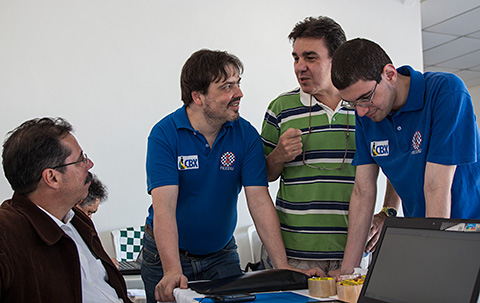
The team of arbiters did a great job of keeping a smooth event
This effectively left three qualifying spots to be fought over by the rest, and a six-way tie for 2nd-7th meant a rapid tiebreaker would need to be organized to decide them. At the top of the list was IM Diego Berardino (2504), followed by IM Roberto Molina, IM Rodrigo Disconzi, IM Christian Toth, FM Renato Quintiliano, and FM Cesar Umetsubo. After seven rounds none had been able to outshine the others and it would now be a cutthroat round-robin rapid tournament played at 15 minutes, with no increment. After the dust had settled, the next three qualifiers for the Brazilian championship were Berardino, Molina, and Toth.
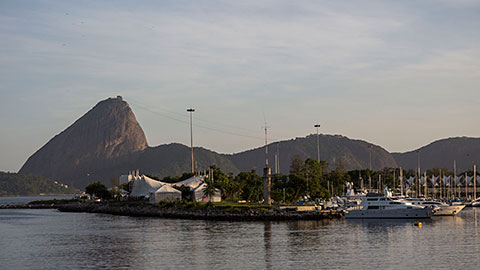
As the last round ended, the sun set on the bay
Final standings
Click here for full standings
